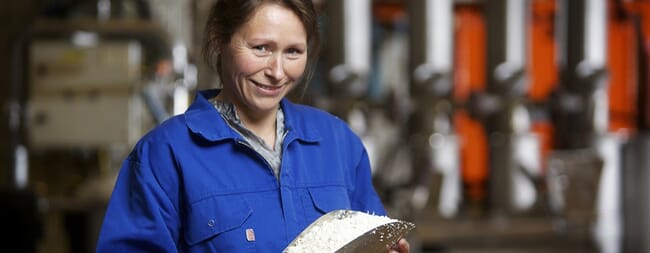Usually less than 10 per cent of the astaxanthin in salmon feed is absorbed, but the new breakthrough by researchers at Nofima in Norway suggests that the bone extract can improve astaxanthin absorption – which could have very positive economic implications.
“It is somewhat unexpected that a mineral ingredient can affect pigment utilisation. But at the same time, it is very positive to see that nutrients liberated from fish bones can considerably increase the utilisation of astaxanthin in salmon feed,” says Sissel Albrektsen, senior researcher at Nofima.

© Bjørn Erik Larsen / Nofima.
She and her colleagues at Nofima have long researched effective ways to better exploit fish bones. Here, they used hydrolysis to free minerals from the bones before adding them to the diets of salmon smolt, and the increase in redness was both visible to the naked eye and confirmed by chemical analyses. Increased astaxanthin exploitation is a very positive side effect that also carries a high market value.
Feed with the phosphorus-rich mineral ingredient was also tested on slightly larger salmon during grow-out from 1.7-2.5kg, and compared with salmon that received the same feed but with a regular source of commercial phosphorus.
The salmon given the whiting extract had 35 per cent more colour in the muscle, while their ability to digest astaxanthin increased by nearly 20 per cent and the pigment levels in both the blood and liver also increased.
“We believe that the main explanation of why the muscle becomes redder is that the salmon digest more of the astaxanthin with the mineral ingredient present in the feed,” says Albrektsen.
It has been repeatedly proven in salmon that the mineral ingredient stimulates increased growth, and in some cases this is explained by increased digestibility of nutrients.
In the initial experiment with smaller salmon, it was found that the astaxanthin levels in blood, liver and whole fish were 55, 29 and 22 per cent higher, respectively, compared with fish that were fed an ordinary source of commercial phosphorus. Why this is so remains to be discovered.
“In an experiment now taking place, we will take a closer look at how minerals and other liberated components in fish bones can affect processes including intestinal function,” says Albrektsen.
The research is part of an ongoing FORNY (renewal) project funded by the Research Council of Norway.


